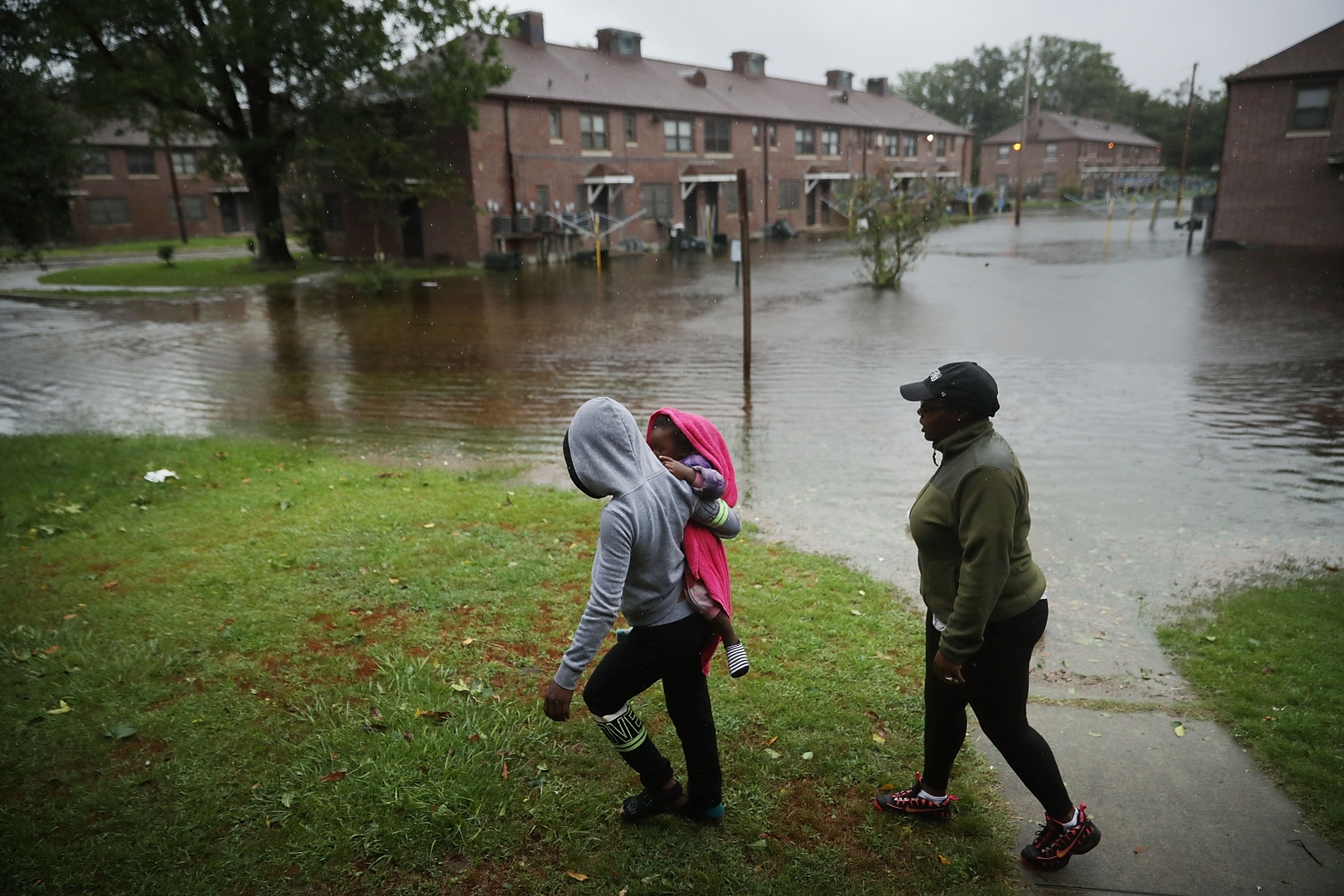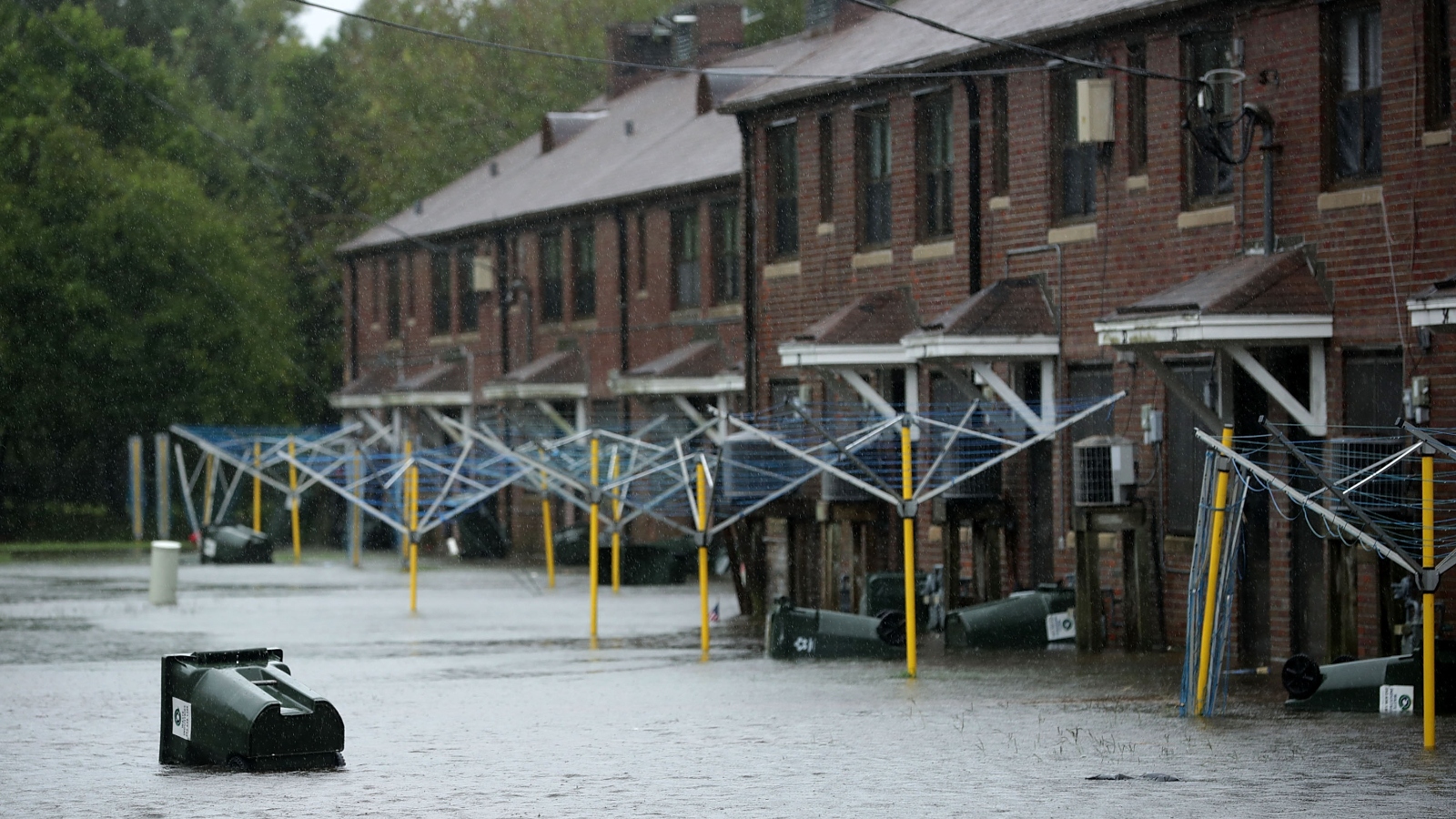As wildfires and hurricanes wreak havoc on American communities year after year, the U.S. Department of Housing and Urban Development, or HUD, has quietly become a central part of the federal government’s response to climate change. The agency has spent billions of dollars over the past decade on long-term recovery projects that supplement emergency aid provided by FEMA, which tends to pull back from disaster areas after a few months. States have used HUD money to rebuild fire stations and hospitals, construct new flood defenses, and buy out vulnerable homes.
When Hurricane Florence spiraled over eastern North Carolina in September 2018, it damaged or destroyed more than 11,000 homes in the space of a few hours. In the aftermath of the storm, the state channeled millions of HUD dollars toward an ambitious effort to build affordable apartments in the areas that had lost big chunks of their housing stock. Restoring this low-income housing is one of the most difficult and expensive parts of disaster recovery, and the HUD money was meant to help ensure displaced renters didn’t have to scatter far and wide to find homes they could afford.
One of the first test sites for the effort was the shoreline city of New Bern, the birthplace of Pepsi. Florence damaged or destroyed almost 2,500 homes and apartments in the city and surrounding Craven County, which were too remote to attract much new investment from private builders. After the storm, the state used HUD money to build a 60-unit apartment complex called Palatine Meadows that is reserved for locals making below the area median income.
But the development may well be arriving too late to make a difference: It will open this month, more than five years after Florence struck, thanks to a mountain of federal paperwork. Documents obtained by Grist through a public records request show that it took two years to set up a program to spend the money, another year to select a site, almost two years to complete a mountain of environmental review paperwork, and another year to build the complex. This timeline was so long that it undermined the initial purpose of the project, which was to provide a timely and affordable option for residents who suddenly find themselves with nowhere to live.
Jeffrey Odham, the mayor of New Bern, says he doubts the new apartment complex will help any of the city’s storm victims.
“There’s people that will take advantage of those units, but someone who was displaced from Hurricane Florence now moving into one of these houses — I don’t think you can make that correlation, because it’s been too long,” he said in an interview with Grist. Odham didn’t know the project was part of North Carolina’s Florence recovery program until Grist informed him. It is the only subsidized apartment project in New Bern that has been built with FEMA or HUD money.
The state department that administers federal recovery funding, Rebuild NC, has faced numerous accusations of delay and financial mismanagement dating back to Hurricane Matthew in 2016. The nonprofit investigative outlet NC Newsline has reported that state officials awarded millions of dollars in building contracts to a construction firm that racked up hundreds of homeowner complaints, relocated storm victims to leaky and moldy homes or hotels that then evicted them, and delayed aid applications for years. (Rebuild NC has defended its spending decisions and blamed delays on the pandemic and supply chain shortages.)
But just as concerning is what happened for the state when everything went according to plan. Even a well-financed housing project built by a trusted developer took more than half a decade to complete.
The sluggish timeline on the New Bern development is symbolic of a much larger problem with HUD’s disaster recovery program, according to Carlos Martín, a researcher at Harvard’s Joint Center for Housing Studies who has followed the agency’s relief efforts. By the time states can develop new housing with HUD money, he said, it’s often too late.
“I’ve heard this story before,” Martín told Grist. “They were doing everything right, and it still took forever.”
The problem starts with Congress: FEMA doesn’t need to get a green light from Congress before it starts sending money for disaster relief, but HUD does. That’s because lawmakers have never passed legislation that authorizes the agency’s disaster program on a permanent basis. Instead they pass standalone funding bills that give the agency authorization to spend on specific disasters, and a community’s recovery depends on whether it can elbow its way onto the agenda of the the House of Representatives and the Senate.
North Carolina was luckier than many places, because Congress passed such a bill mere weeks after Hurricane Florence, giving the state more than $336 million for storm recovery. Lawmakers added another $206 million the following year. By congressional standards, this was a fast turnaround: Other hard-hit areas such as Lake Charles, Louisiana, have had to wait more than a year after disasters for lawmakers to allocate funding.
The half-billion-dollar grant from HUD was far more than North Carolina could have hoped to raise on its own, but it took ages for the money to reach the state. Because Congress passes each HUD disaster allocation as a separate bill, HUD has to create new rules for how it spends each new infusion of money, then solicit public feedback on those rules in order to comply with the Administrative Procedure Act. The feds must then review and edit “action plans” from each state that receives money, making detailed decisions about what projects to fund.
North Carolina aimed high with its post-Florence action plan. Housing was the biggest need after the storm, and officials wanted to go beyond traditional FEMA programs that reimburse storm victims who relocate to hotels and existing apartments.
“These [reimbursement] programs are beneficial to renters, but may not be best suited to meet the renter recovery need of such a vast geography,” state officials wrote in a 2021 report, adding that a better approach would be “to create new housing stock in a way that is more responsive to the needs of the recovering community.”
The private market was never going to build back low-income housing on its own in eastern North Carolina. Almost all new affordable housing — whether in disaster-struck areas or anywhere else — relies on government subsidies, most notably the federal Low Income Housing Tax Credit, which allows developers to claim tax breaks for the expenses of building new units at below-market rates. But even that credit wasn’t generous enough to bring developers to the impoverished towns that had been destroyed by Florence; it would take the extra inducement of HUD money to get developers to build new low-income apartments in places like New Bern.

In 2021, after the state completed months of paperwork to set up its action plan, it sought out builders who were interested in taking advantage of the HUD money. One of the bids was from an established affordable housing developer called Woda Cooper, which owns dozens of apartment complexes across the country. Woda had found an empty lot off a major thoroughfare in western New Bern, just down the road from a high school and well inland from the coast. The lot had been vacant for decades, and it wasn’t exactly a moneymaker, but by stacking HUD money on top of other federal tax credits, Woda could make the project pencil out.
Finding the developer was only the start of the process, because the HUD funding was subject to dozens of laws and regulations that restrict how the federal government spends money. These regulations have piled up over the decades to protect wetlands, endangered species, drainage systems, historic assets, and people who live near construction sites. Together they created a set of additional hurdles that Woda and Rebuild NC had to clear before the development could break ground.
“We stress repeatedly to everyone that we’re partnering with, ‘don’t disturb any ground, don’t spend any money, don’t do anything until we clear the environmental review process and have permission from HUD,’” said Tracy Colores, the community development director at Rebuild NC, who managed the housing program.
That review process took most of 2022. In order to comply with endangered species laws, the state engaged in a monthslong back-and-forth with the U.S. Fish and Wildlife Service to figure out whether cutting down trees on the site might threaten migration stops for the northern long-eared bat. (It didn’t.) In order to ensure the complex didn’t violate any historic preservation laws, officials sought comment from two Native American tribes, who didn’t express any concerns. There was a Superfund site at a defunct power plant almost a mile away from the lot, so the state had to check in with another state agency about the potential risk of groundwater contamination, which was nonexistent. Rebuild NC had to contact a separate department to check whether there were any underground fuel storage tanks in the area, which there weren’t, or aboveground fuel tanks that could explode, which there also weren’t.
Furthermore, a small corner of the parcel sat within a FEMA-designated flood zone. Even though the developers weren’t going to build in that corner, they did plan to cut down a few trees, which triggered another review under an executive order issued in the 1970s, which regulates flood zone construction. The state liaised with the local floodplain administrator, completed an exhaustive report on flood risks, redid site plans to add a retention pond, and ran a public notice about the proposed tree-cutting in a local newspaper — all to mitigate “temporary impacts to .01 acres” of floodplain, an area roughly the size of a two-car garage.
The state had to undertake yet another review process when they realized that a ditch on the property counted as a federally designated wetland because it contained stagnant water. The developer needed to replace two concrete culverts that drained into the ditch, expanding the 15-inch pipes to 18 inches, but under federal law this action counted as new wetland development under the Clean Water Act, which meant the developer had to seek a permit from the U.S. Army Corps of Engineers. Meanwhile, the developer and the state spent months waiting for HUD approval to sell a portion of the lot that contained a cell phone tower, which conflicted with land use regulations governing the federal Low Income Housing Tax Credit.
HUD handed down final permission to use federal money for the project in November, more than four years after Florence made landfall, at which point Woda Cooper closed the deal to buy the land and started preparing the site for construction. They cleared the lot during the first half of 2023, and by the time the fifth anniversary of Florence came around, they were about halfway done building the apartments themselves. The construction timeline stretched on for a few extra months due to a supply-chain snag with the building’s electrical system, but otherwise things went according to plan. The first tenants are expected to arrive later this month.
The other developments in the state’s housing program aren’t much further along. Out of the 16 post-Florence apartment projects that the state chose to fund with HUD money, seven are complete or almost complete, including Palatine Meadows, and six are in various stages of construction. Two projects have received their authorization from HUD but haven’t yet broken ground, and one project fell through after the state couldn’t find a suitable developer. Meanwhile, a separate effort to rebuild one of New Bern’s largest public housing projects with money from FEMA has yet to get off the ground.

On one hand, these new low-income units would likely never have been built at all were it not for the infusion of money from HUD. Other federal programs helped Florence victims find new housing throughout the state, but the HUD money built new housing in the same places that lost it. Denis Blackburne, the senior vice president of Woda Cooper, told Grist that “without this [HUD] funding source, this development [Palatine Meadows] would not have been feasible” and that the federal money didn’t delay the building process.
On the other hand, Palatine Meadows may be arriving too late to change the trajectory of New Bern’s rebuild. Odham, the city’s mayor, says that most New Bern homeowners who suffered damage during the storm have returned and rebuilt their houses with money from insurance and federal grants. Renters, on the other hand, have almost all moved away: The city didn’t have any available apartments in the years after the storm, so renters who lost their homes had no choice but to look elsewhere for replacement housing.
“The question of whether people came back would come down to whether it was owner-occupied, or whether it’s rental property,” he said. “For rental property, I would say that most of those folks have probably turned over. They left to go find somewhere else to live.”
Martín, the Harvard researcher, says that other states like Louisiana and New York have also seen long delays when they try to develop new housing with HUD money.
“Affordable housing projects tend to take the longest for all grantees,” he said. “It certainly helps to have more housing, but if we’re looking at the people who lost their housing back in the disaster, I’m pretty sure it does very little for them.” HUD’s own inspector general found in a December report that the agency has taken longer and longer to deliver disaster funds: The average time between the passage of a disaster bill and the disbursement of funds to states tripled from around 200 days to around 600 days between 2000 and 2022.
In response to questions from Grist, a spokesperson for HUD said that the agency is working on a plan to streamline the funding process for its disaster program — and that it has asked Congress to authorize the program on a permanent basis.
Martín says Congress should also add exemptions to the environmental review process that would allow states to move through reviews faster if they’re working on affordable housing projects that are below a certain size, or projects in urban areas that are already developed. The state of California has added such exemptions to its own environmental laws as part of an effort to build more low-income housing, and a recent executive order Los Angeles mayor Karen Bass has streamlined permitting reviews for new infill housing, leading to thousands of new units. For a project like Palatine Meadows, which brought just 60 units to an existing neighborhood, such exemptions might have sped up the timeline by a year or more.
Colores, of Rebuild NC, told Grist that the housing development project was worth doing even on a prolonged timeline. She added that new apartment complexes like Palatine Meadows will ease local housing shortages and provide new housing stock that will be strong enough to withstand future storm events.
“To the extent that we can leverage these HUD dollars, we can make a significant difference in the quality and quantity of affordable housing in a lot of communities that are frequently hit by storms,” she said. However, she acknowledged that for many victims of Hurricane Florence, the ribbon-cutting on Palatine Meadows will be too late to make much of a difference.
“I wish that we could move more quickly,” she said.



